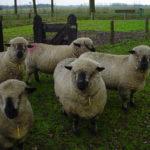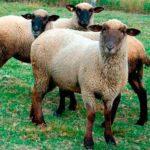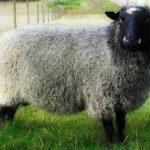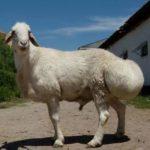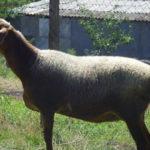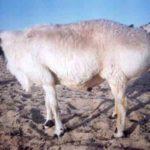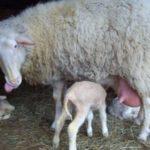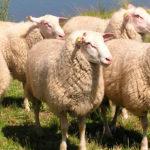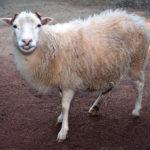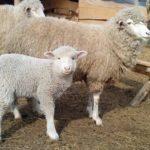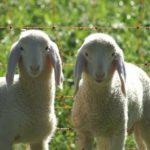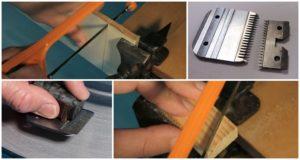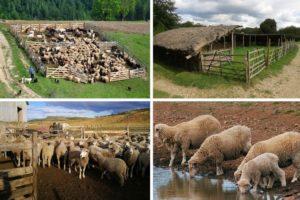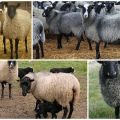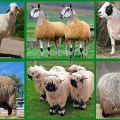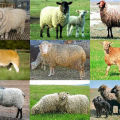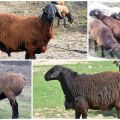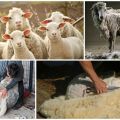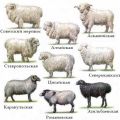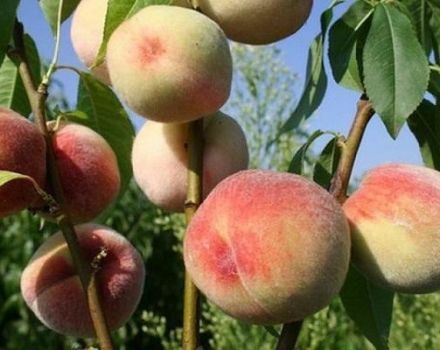Description of breeds and varieties of sheep, which to choose for breeding
A huge variety of ram and sheep breeds satisfies the needs of people for meat, wool, leather, milk, from which delicious cheeses are made. These are animals that feed only on grass and hay all year round. Their maintenance costs are minimal. As adults, rams weigh from 65 to 180 kilograms (depending on the breed). In addition, some varieties of these animals produce the finest high-quality wool.
Meat breeds
From time immemorial, sheep have been raised for meat. In the course of folk (natural) selection, the most productive animals were bred. Meat breeds are distinguished by their heavy weight, muscular body and early maturity. Slaughter meat yield after slaughter is more than 50 percent.
Any animal of the meat direction intensively recovers in the first months of life. During this period, all the food eaten by the rams goes on to gain weight. Sheep grow up to 2-3 years, then their growth stops. Pets are usually slaughtered at the age of 8-12 months. By this time, they are gaining 50-70 kilograms of weight.
Meat breeds: Suffolk, Romanovskaya, Gorkovskaya, Kuibyshevskaya, Romney-marsh. This group includes: North Caucasian, Latvian dark-headed, South African dorper, French Vendée, zwartbles, texel, prekos. All these animals are united by such basic characteristics as high weight (75-130 kg), muscular (meat) constitution, high slaughter yield of meat (50-55%). Females are usually smaller than rams. But they give birth to 1-3 cubs, the mass of which at birth is equal to 3-5.5 kilograms.
Meat and greasy sheep
Animals of the meat and fat direction are bred for the sake of obtaining meat and fat tail fat. This group usually includes Asian sheep breeds. The most famous coarse-haired: Gissar, Edilbaevskaya, Dzhaidara. Semi-coarse-haired: Saraja, Tajik, Alai, Degeres.
All rams of the meat-and-grease direction have the following characteristics in common: large forms, large weight (70-130 kg), the presence of a fat tail in the back of the body. The wool of these animals is usually of poor quality. A fat tail accumulates from 5 to 35 kilograms of fat tail fat.
The animals are bred in the republics of Central Asia and in the steppe regions of Russia, where sheep breeding is the main direction of animal husbandry. In Asian countries, there are even separate areas for breeding meat and lard rams. Breeding animals are highly productive. There are meat, fat tail and meat and greasy directions.
Dairy direction
After the birth of lambs, sheep give from 1 to 3 liters of milk per day. In terms of fat content, it is one and a half times higher than goat and three times that of cow. The fat content is 5-7 percent, protein - 6 percent. Delicacy cheeses (Roquefort, feta, pecorino, ricotta), yoghurts and feta cheese are made from sheep's milk. Of course, all sheep lactate after lambing. However, there are animals with the highest milk yields. Scientists are working on breeding productive breeds, in addition, dairy sheep breeding in some countries enjoys state support.
Breeds of dairy sheep: German East Frisian, White Sardinian, Laconian, British Dairy, Chios with black spots on the horned head and ears, Arabian Avassian with a brown head, Israeli Assaf with long ears, Dutch zwartbles. Females are milked after lambing. Sheep usually give birth to lambs in the spring. Lactation is maintained until autumn. When the lambs grow up, the milk disappears. The next lactation occurs after the next birth.
All animals of the dairy direction are united by such common characteristics: for lactation from one sheep receive up to 300-600 liters of milk, females are fertile, the weight of animals is, on average, 50-70 kilograms.
Meat and wool rams
For the sake of the highest quality wool, fine-wool and semi-fine-wool sheep are bred. These two main groups of animals are divided into subgroups according to the prevailing productivity. Fine-woolen ones are wool (Grozny, Australian merino, Salskaya), wool-meat (Altai, Askanian), meat-wool (Volgograd, Vyatka).
Semi-fine-wool varieties: long-haired (Kuibyshev, Romney-marsh, North Caucasian), short-haired (Gorky), wool-meat (Tsigai, Gorno-Altai).
From 3 to 15 kilograms of high-quality wool is sheared from sheep per year. The fleece of sheep of fine-wool and semi-fine-wool breeds is fluffy, thin and soft. Animal wool is used in the knitting industry. When breeding meat and wool breeds, not only fleece is obtained, but also meat. True, the weight of adult animals is inferior to meat breeds and averages 50-70 kilograms.
How to choose the right breed
Sheep and rams are selected depending on the purpose of breeding. For the sake of obtaining meat, it is better to purchase meat animals. They usually buy sheep, which have been raised in a specific area for many years. The animals are raised for sale by pedigree farms and ordinary farmers. Beef sheep should weigh 40-45 kilograms already at the age of 5 months. Usually these are hornless individuals with well-developed muscle mass.
Better to buy young animals 6-12 months old. Adult sheep are seldom sold, only if they are sick, old, or have low productivity (little wool, milk, poor weight gain, low fertility).
The age of the rams can be found by looking in their mouth.In young animals, all teeth are healthy, white and intact. With age, they begin to fall out. Toothless animals are deprived of the most important thing - they have nothing to chew on grass and hay. Of course, such rams will not live long.
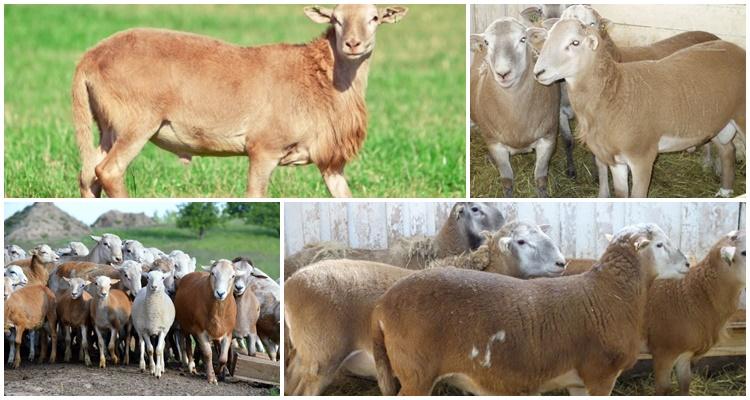
A healthy animal should have proportionally developed body parts. Pay attention to the chest, back, limbs, head shape. A healthy rectangular pet has a muscular body, straight and wide-set legs, a short neck, and an elongated hornless head. Some breeds (dairy, fine-wool) are horned.
When buying wool (fine-wool or semi-fine-wool) rams pay attention to the quantity and quality of wool. It is important to remember that a large amount of hair in animals should be everywhere, even on the belly. Sheep with short, thin wool have folds on the skin, the optimal number of them is 3 on the neck and several on the body. The fineness of the rune is determined by eye, while looking at at least 6 curls in 1 cm. The length of the coat should be 6 cm or more. When choosing dairy sheep, attention is paid to the shape of the udder and the number of lambs born at the same time. The higher the fertility, the more milk the females give.
It is not recommended to buy a sheep that has a hard or sore udder. Most likely, the female has mastitis, and this disease can affect the fertility of the animal.
When buying young lambs, you need to ask whether they have been vaccinated against anthrax, foot and mouth disease, smallpox, brucellosis. It is recommended to ask when the rams were given antihelminthic drugs. In novice sheep breeders, these animals die due to worms.
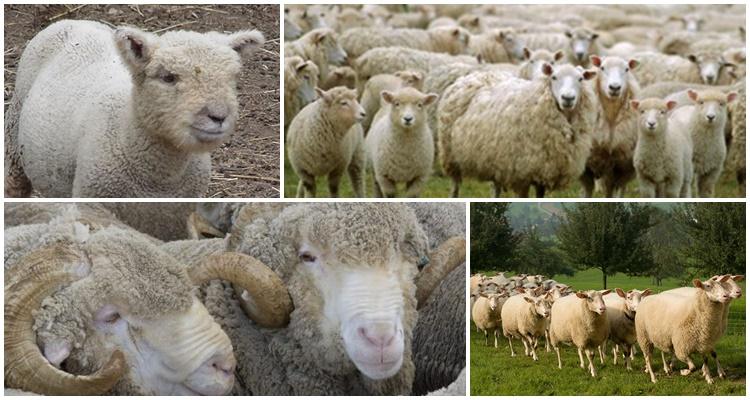
What breeds of sheep are most profitable for breeding in our country?
In each country, sheep are grown adapted to the local climate and pastures. These animals were domesticated many millennia ago. Each region has its own local sheep breeds. True, this does not mean that animals will not be able to take root in another area. The main thing when raising rams is the presence of pasture, a reservoir or water for drinking and a place where they will be kept during the cold winter.
It is more profitable to raise sheep of meat breeds. The costs of breeding such animals are minimal. Sheep eat grass in summer and hay in winter. The meat can be easily marketed. To obtain a sheepskin coat, Romanov sheep are bred. This breed is well known in the Yaroslavl, Kostroma, Novgorod regions, as well as in Belarus. Smushki are obtained from the Karakul breed, which has been bred for more than a dozen years in the Astrakhan region and Kalmykia.
Meat-greasy sheep are bred for the sake of meat and fat tail. These are large animals that grow quickly and gain up to 180 kg of weight in adulthood (Hissar). They are grown in Kalmykia, Astrakhan, Saratov, Volgograd regions and in the republics of Central Asia.
Sheep of fine-fleece and semi-fine-fleece breeds (Salskaya, Russian, Merino) are bred if the fleece can be sold. Traditionally, these rams are raised in the regions of the North Caucasus, Stavropol Territory, Kalmykia, Altai Territory, Transbaikalia. These animals are bred in the Samara, Ryazan, Oryol regions.
